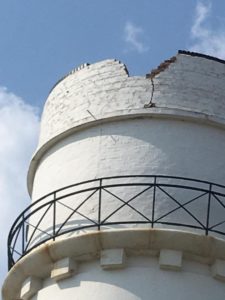When lightning strikes are you protected against this act of God?
The nature of church architecture means they are particularly prone to lightning strikes. The very act of projecting the building towards heaven with a tower or spire – to glorify God and to act as a landmark for miles around – works towards them attracting lightning.
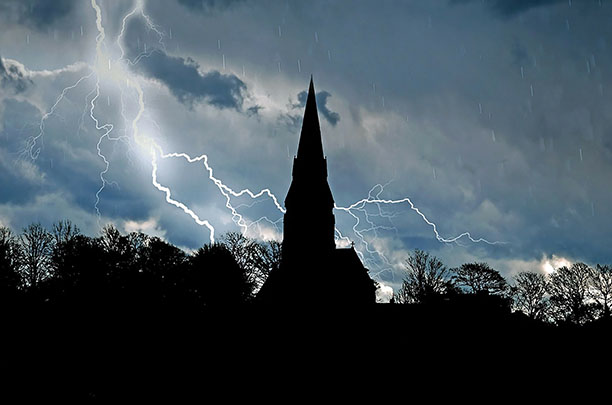 The issue of lightning protection in churches is one that has exercised this publication for many years. In this four-part series of spotlights on the issue we will be revisiting various aspects of the subject, beginning with an overview of current thinking.
The issue of lightning protection in churches is one that has exercised this publication for many years. In this four-part series of spotlights on the issue we will be revisiting various aspects of the subject, beginning with an overview of current thinking.
The nature of church architecture means they are particularly prone to lightning strikes. The very act of projecting the building towards heaven with a tower or spire – to glorify God and to act as a landmark for miles around – works towards them attracting lightning.
 “Churches have always suffered from the effects of lightning.” That is the very start point of guidance published jointly by Historic England and Ecclesiastical Insurance. The document comprises a detailed summary of the history of church approaches to lightning strikes over the centuries, in particular the number of instances some buildings seem to have fallen victim. It quotes R H Golde, writing in his 1977 work Lightning Protection, as noting that the campanile of San Marco in Venice was hit and either severely damaged or destroyed no fewer than nine times between 1388 and 1762.
“Churches have always suffered from the effects of lightning.” That is the very start point of guidance published jointly by Historic England and Ecclesiastical Insurance. The document comprises a detailed summary of the history of church approaches to lightning strikes over the centuries, in particular the number of instances some buildings seem to have fallen victim. It quotes R H Golde, writing in his 1977 work Lightning Protection, as noting that the campanile of San Marco in Venice was hit and either severely damaged or destroyed no fewer than nine times between 1388 and 1762.
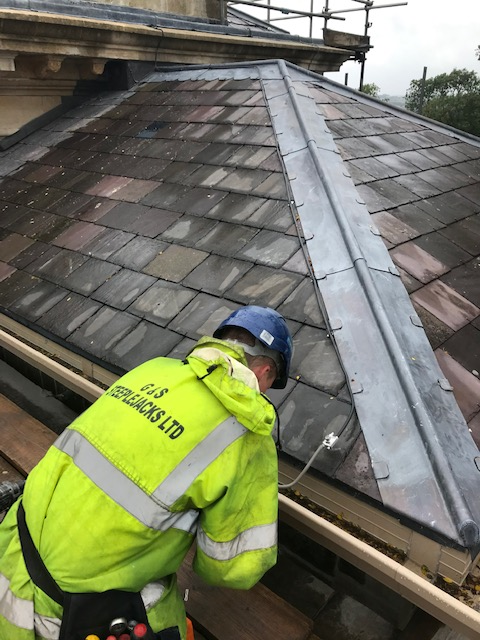
G & S Steeplejacks have recently installed a new Lightning Protection System on Bitton Hill House, near Bristol, in line with BS EN 62305:2011.
For further information on the company and the services they offer visit www.gnssteeplejacks.co.uk
In Britain the effects have not been so severe, as we suffer comparatively fewer strikes per hectare than elsewhere.

Annual inspection advice for lightning protection
Ecclesiastical Insurance, by far the biggest church insurers, make the following recommendations for lightning inspection for churches.
After a period of running in parallel, from the end of August 2008, BS 6651 has been replaced by BS EN 62305. The new standard incorporates hundreds of changes and is considerably larger and more complex. There are four main parts covering (1) General Principles (2) Risk Management (3) Physical Damage to Structures and Life Hazard and (4) Electrical and Electronic Systems within Structures.
The protection of electronic equipment is now an integral part of the standard. Whilst BS 6651 recommended that lightning protection systems should be inspected and tested at fixed intervals, preferably not exceeding 12 months, the maximum interval under the new standard is four years; it may be convenient to reduce this to two and a half years to fit the quinquennial inspection cycle, with an annual visual inspection.
Early approaches by ecclesiastical authorities seem to have been that, as lightning is an act of God, there is no justification or need to attempt to protect a church against it. That attitude changed in the 19th century as technological advance resulted in the development of lightning protection systems based on the Franklin rod – a single metal rod leading to earth, in churches also known as a ‘tower-only’ system.
Until recently the great majority of churches still had that kind of basic protection, despite the introduction in the last century of a British Standard, BS6651, that recommended the more sophisticated Faraday Cage system, described by Ecclesiastical Insurance as ‘a mesh of conductors at intervals laid over the roof and down the walls of the building, and connected to earth by earth electrodes’.
When dealing with the issue of lightning protection in ancient or listed churches, as with any historic building, consideration has to be given to conservation issues.
In the joint Historic England/Ecclesiastical Insurance document Lightning Protection for Churches – a Guide to Design and Installation the policy of Historic England is stated thus:
New guidance published
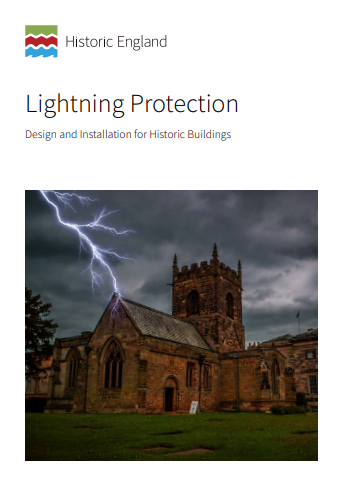
To comply with the current British Standard, the majority of buildings should have their lightning protection system tested every year. As this is highly specialist work, it is crucial that it is carried out by a specialist contractor with the knowledge and experience to ensure its continued safety to the recognised UK standard.
Click here to find out more about Historic England's new guidelines for your premises.
“The installation of a lightning conductor implies in most cases the fixing of equipment to the fabric of a building. English Heritage seeks to ensure that any works to a historic building do not unnecessarily disturb or destroy historic fabric.“In deciding how best to protect a church from the effects of lightning the principals of minimum intervention and reversibility should be adopted wherever and whenever possible.”
In the same document Ecclesiastical points out that, although lightning protection is not a condition of cover “…installing lightning protection, as part of a risk assessment strategy, together with its on-going maintenance and testing, not only serves to protect the building for future generations to enjoy, but should help to reduce claims costs in the longer term.”

Lightning protection: the new standard explained
In May Historic England began a series of webinars aimed at providing technical guidance for owners and operators of historic buildings, as well as contractors and heritage professionals. Tagged as Technical Tuesdays, the webinars are presented by senior members of Historic England’s technical conservation team.
Click here for the full story
In 2008, a new European standard came into play: BS EN 62305. The new standard is considerably more complex than its predecessors and includes a requirement for a risk assessment to determine the level of protection required and sections devoted to both structural damage and risk to life, as well as damage to electrical installations and equipment.
Ecclesiastical Insurance has published a short guidance note to the main points of BS EN 62305. The company states: “This is only a brief summary of a very complex subject. Specialist advice must always be sought before installing any electrical equipment and installation must only be undertaken by competent persons.
“The design of a lightning protection system should be carried out by a specialist such as a consulting engineer, preferably a member of the Association of Consulting Engineers, with experience in lightning protection systems.”
 Similarly, the company states that the installation should only be carried out by a competent and experienced contractor specialising in lightning protection systems.
Similarly, the company states that the installation should only be carried out by a competent and experienced contractor specialising in lightning protection systems.
A more extensive explanation of the differences between the old and new standards is the subject of a further joint publication, which allows updates of specific guidance documents. Again, it is a given that specialist advice should be sought.
The document states: “The most significant changes are the approach and enlargement of the risk assessment process and the inclusion, within the main body of the text, of specific guidance on the application and testing of surge protection devices as part of the risk assessment calculation.”
In future issues we will be considering the different kinds of damage that lightning can cause and the various ways of defending churches against it, and the issue of lightning protection in non-ecclesiastical historic buildings.
You can find an expert near you in our directory here
Does your business require lightning protection?
Here in the UK, we’re blessed with relatively calm weather. However, while we might not be subjected to hurricanes or tornadoes, we do get our fair share of electrical storms. On average, the UK and its surrounding waters are hit by around 300,000 lightning strikes every year, and while these powerful displays of nature are stunning to watch, they also pose significant risk to both people and structures.
Click here to read the full story.

Lightning protection standard updated
The four-part international standard for lightning protection, BS EN IEC 62305, has been updated to reflect the latest expert knowledge and best practices. Together, the documents form the essential guide for anyone involved in safeguarding structures, their occupants and systems from the damaging effects of lightning.
Click here to read the full story.

Sightseeing from height in Brighton
One of the most famous and breathtaking locations to visit in Brighton is the landmark St Bartholomew’s Church. Known for its Gothic Revival architecture, the church was built between 1872 and 1874 and is one of the tallest churches in England.
Click here to read the full story.

Lightning protection and steeplejacking body passes third quarter century
This year marks the 75th anniversary of ATLAS, the body representing lightning protection companies and other access at height specialists. Its members have been at the forefront of the lightning protection and specialist access trades for many years and undertake access, inspection, repair and maintenance work on a range of structures – in particular churches and heritage buildings.
Click here to read the full story.
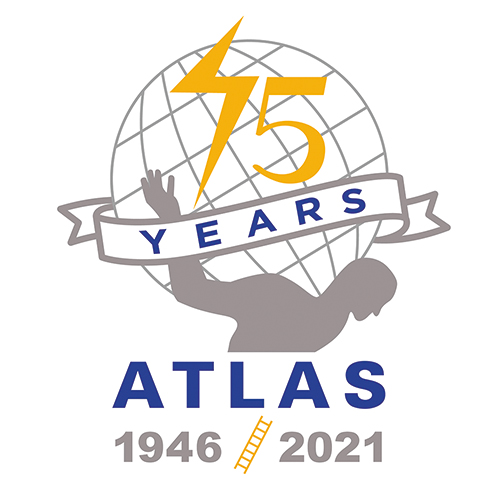
Lightning protection for historic properties
Lightning protection for historical buildings is particularly important in order to protect and preserve the heritage of the building. However, as Adrian Brown of Nottingham-based Lightning Strike Ltd explains, historic buildings weren’t constructed with lightning protection as a consideration, so it’s important that the appearance of the system doesn’t appear out of character and intrusive.
Click here to read the full story.

Un-lucky Strike
Last month, in just a single day, the UK was hit by more than 40,000 lightning strikes.
Pure gold for the press with dramatic and terrifying images literally flooding the news channels.
What the media didn’t show, however, was the indirect strikes and the resulting internal power surges causing damage to buildings and businesses across the country.
Click here to read the full story.

ATLAS publishes latest edition of 21st Century Steeplejack Campaign
ATLAS has published its latest edition of its 21st Century Steeplejack Campaign to raise awareness of the diverse range of access methods and services its members can offer, aware that many associate steeplejacks with only ladder access to churches.
The Campaign involved a series of posters being distributed to different industries and ATLAS members, with the first being process engineering plants and the second being ecclesiastical buildings, where ATLAS featured in Ecclesiastical and Heritage World. If you would like to receive a copy or copies of the posters in the mail please complete the ecclesiastical buildings order form.
Click here to read the full story.
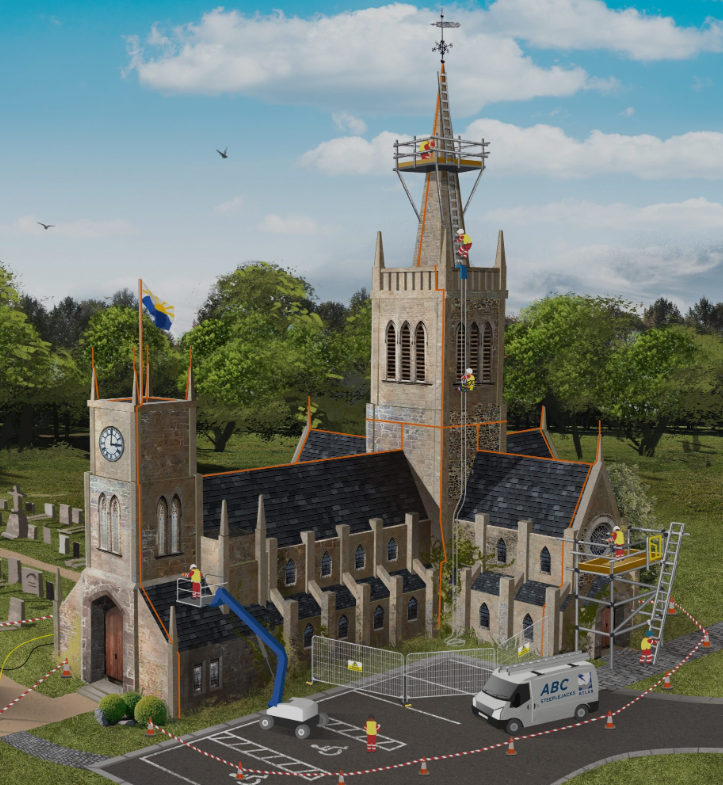
Summertime and the lightning is striking!
With summer in the offing there is actually a greater risk of thunderstorms and lightning strikes. That is because they occur in specific conditions, requiring two basic elements – moisture and rapidly-rising warm air. High humidity combines with warm temperatures to create a large amount of warm, moist air that can form a thunderstorm as it rises into the atmosphere.
Adrian Brown of lightning protection experts Lightning Strike Ltd has researched the causes of the increase in storms and explains it in his blog.
Click here to read the full story.
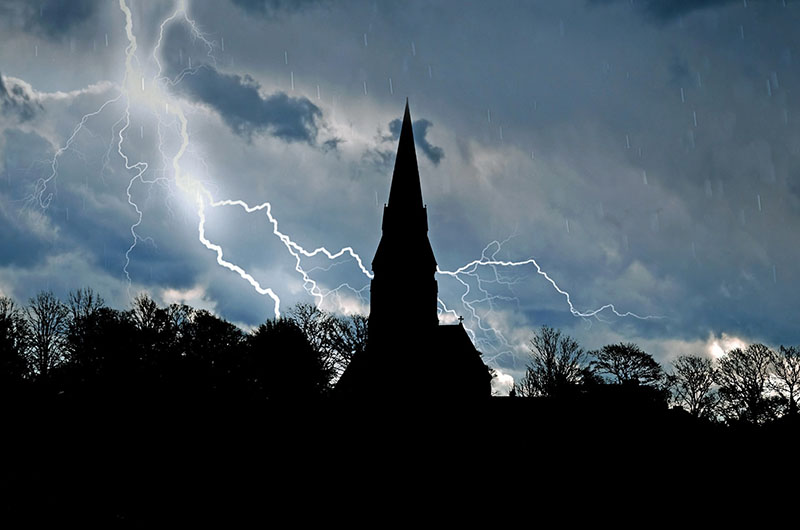
Refurbishment restores Nottingham Castle Rock to its former glory
Nottingham Castle Rock is an ancient monument surrounding several areas of the world-famous Nottingham Castle. Originally constructed in 1068, time has seen the structure and its encompassing roads, caves and tunnels, be subject to ruin and deterioration.
Click here to read the full story.
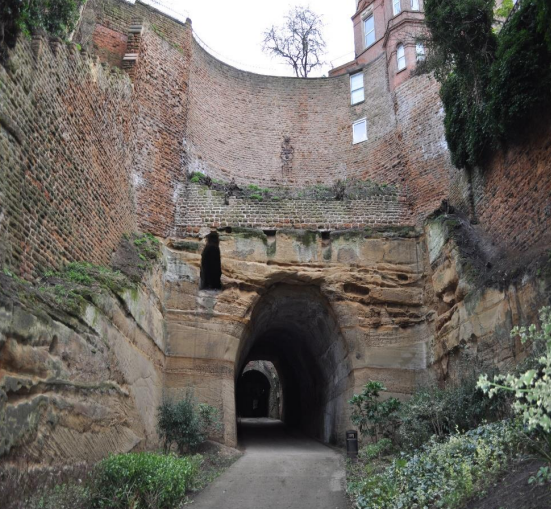
Historic bottle kiln works by Horizon
Horizon was called in by the operators of this disused historic bottle kiln to offer a solution to ‘temporary job’ undertaken by others in order to weather seal the kiln.
Click here to read the full story.

A complex and high risk major repair made the more easier by a touch of kindness
The Tower and Spire of St Thomas’ Church in St Helier Jersey stands approximately 196 feet above ground level. The Tower is 33.83m (111ft) in height and the Spire is 25.9m (85ft) in height. The Tower and Spire are constructed from Brittany Granite and is of mid Victorian Gothic design.
Click here to read the full story.
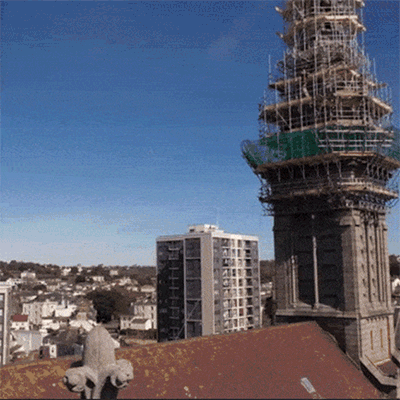
Lightning can be a benefit as well as a threat
To many people the idea of lightning being anything other than a threat to life and property would be unthinkable; but in a recent blog on their website, Nottingham-based Lightning Strike Ltd have pointed out that in many ways lightning can have a positive impact on the natural world.
Click here to read the full story.
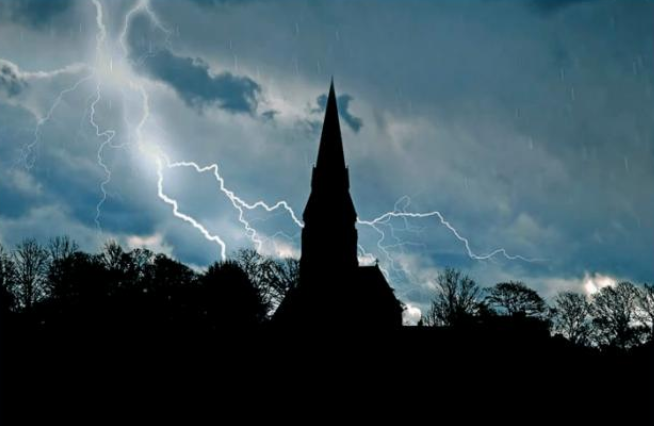
Stop churches from suffering the effects of lightning
Direct Strike Ltd are a business that specialises in safeguarding people and properties against lightning. As a result, they feel that it is their duty to do whatever they can for their customers. One thing they do for them is supply the most effective lightning protection testing Carlisle has to offer. The team carries out comprehensive checks and leaves nothing out.
Click here to read the full story.

Video takes us on a lightning journey through 75 years of history
This year marks the 75th anniversary of the Association of Technical Lightning and Access Specialists (ATLAS) – the trade body that represents the lightning protection and specialist access industry. To celebrate this poignant milestone in its history, ATLAS takes us on a journey through 75 years of history in a new video, comparing landmarks in its history to worldwide events.
Click here to read the full story.

Horizon help to restore Nottingham Council House clock
Horizon Specialist Contracting’s Steeplejack division were recently contracted to help undertake the repairs and restoring of the Nottingham Council House clock for the first time in 25 years. Standing at 42.7m a team of three Steeplejack engineers over a period of three weeks abseiled from the roof of Nottingham’s Council House to replace sections of steel on the clock face which had rusted and rotten over the years.
Click here to read the full story.
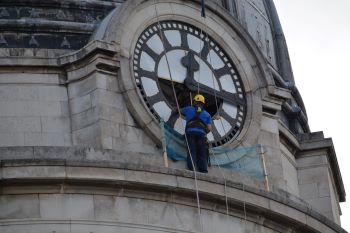
Grade 2 Listed accommodation - Coventry
Rafferty Lightning Protection have been appointed to deliver a brand new BSEN 62305 Lightning protection system to a Grade II Listed former Hospital complex which is being converted into Student accommodation.
Click here to read the full story.
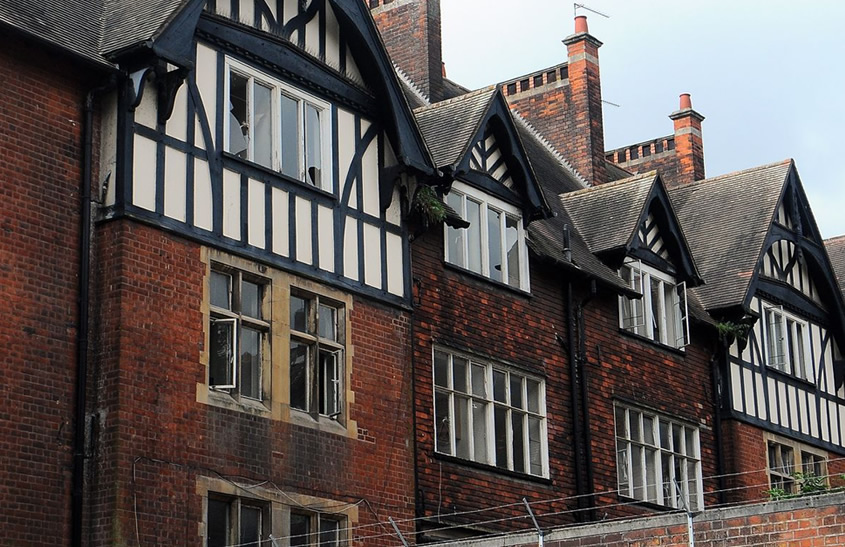
Temporary renewals implemented for lightning conductor engineer and steeplejack CSCS cards
The Association of Technical Lightning & Access Specialists’ (ATLAS) Council has voted in favour of temporarily amending the standard CSCS card renewal requirements for its sector, due to coronavirus severely restricting access to training. This has meant the suspension of the requirement for an Anchors for Steeplejacks and/or Working at Height for Lightning Conductor Engineer course in order to renew blue or gold Steeplejack and/or Lightning Conductor Engineer CSCS cards.
Click here to read the full story.

A C Wallbridge upgrade lightning protection at Romsey Abbey
A C Wallbridge carrying out the upgrading of the lightning protection system to the latest British Standard BS-EN-62305 at Romsey Abbey. Engineer Jake can be seen getting some rope time in.
Click here for more from this company.
New lightning conductor system that’s up to standard
Horizon recently removed an old and inadequate lightning conductor system from a church and replaced it with a new and up to standard system in line with BS EN 62305;2011
The old single bare copper down conductor had oxidised over the years and was not pleasing to look at, this was not helped by the unsightly installation of the tape by the original installer that had it running down the middle of the clock face of the church tower. Horizon removed the old tape by installation steeplejack ladders to the summit of the church spire and then using rope access techniques abseiled down the spire to remove the old tape and fixings..
Click here to read the full story.
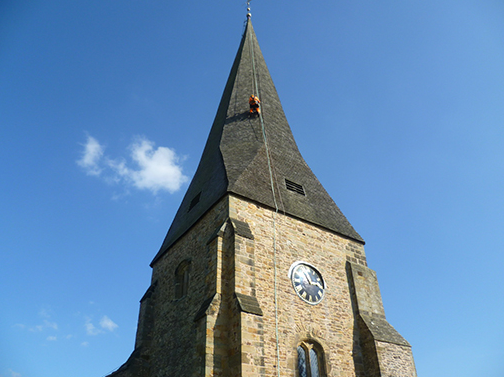
Lightning strike causes structural damage to lighthouse
Over one weekend in August last year it was reported that a staggering 90,000 lightning strikes hit the UK. The Old Hunstanton Lighthouse in Norfolk was a victim of one those strikes and the photograph shows the severity of structural damage that can occur as a result of direct lightning strike.
The structural damage caused to the lighthouse, and the subsequent risk the falling brickwork and masonry posed to the residents and members of the public, emphasises the importance of having an up to date and certified lightning protection system fitted to your building to prevent costly structural damage, or worse, loss of human life.
Click here to read the full story.
